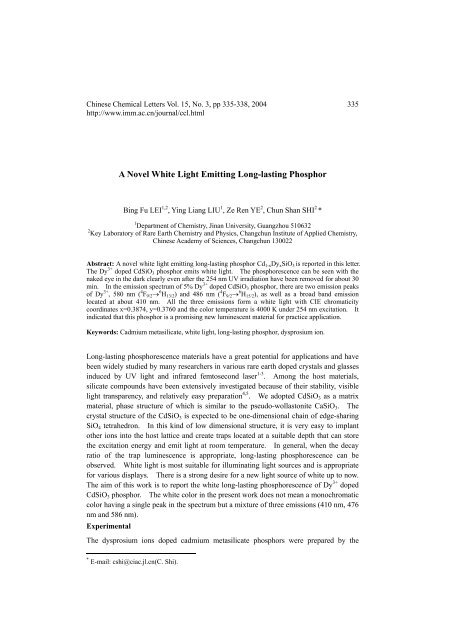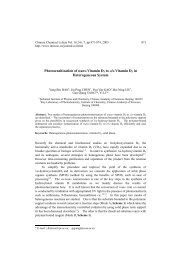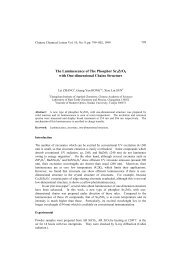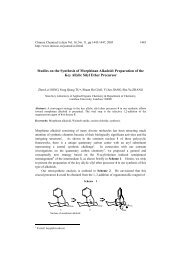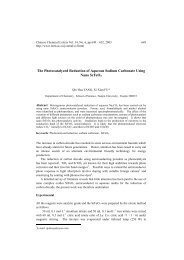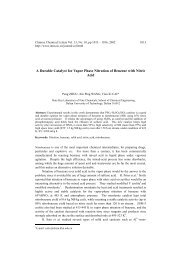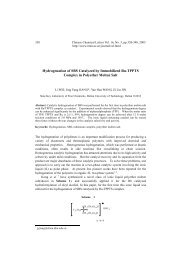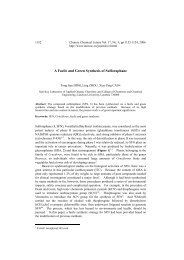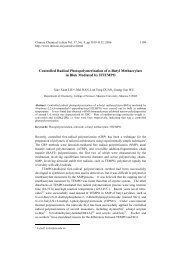A Novel White Light Emitting Long-lasting Phosphor
A Novel White Light Emitting Long-lasting Phosphor
A Novel White Light Emitting Long-lasting Phosphor
You also want an ePaper? Increase the reach of your titles
YUMPU automatically turns print PDFs into web optimized ePapers that Google loves.
Chinese Chemical Letters Vol. 15, No. 3, pp 335-338, 2004<br />
http://www.imm.ac.cn/journal/ccl.html<br />
A <strong>Novel</strong> <strong>White</strong> <strong>Light</strong> <strong>Emitting</strong> <strong>Long</strong>-<strong>lasting</strong> <strong>Phosphor</strong><br />
Bing Fu LEI 1,2 , Ying Liang LIU 1 , Ze Ren YE 2 , Chun Shan SHI 2 *<br />
1 Department of Chemistry, Jinan University, Guangzhou 510632<br />
2 Key Laboratory of Rare Earth Chemistry and Physics, Changchun Institute of Applied Chemistry,<br />
Chinese Academy of Sciences, Changchun 130022<br />
Abstract: A novel white light emitting long-<strong>lasting</strong> phosphor Cd 1-xDy xSiO 3 is reported in this letter.<br />
The Dy 3+ doped CdSiO 3 phosphor emits white light. The phosphorescence can be seen with the<br />
naked eye in the dark clearly even after the 254 nm UV irradiation have been removed for about 30<br />
min. In the emission spectrum of 5% Dy 3+ doped CdSiO 3 phosphor, there are two emission peaks<br />
of Dy 3+ , 580 nm ( 4 F 9/2→ 6 H 13/2) and 486 nm ( 4 F 9/2→ 6 H 15/2), as well as a broad band emission<br />
located at about 410 nm. All the three emissions form a white light with CIE chromaticity<br />
coordinates x=0.3874, y=0.3760 and the color temperature is 4000 K under 254 nm excitation. It<br />
indicated that this phosphor is a promising new luminescent material for practice application.<br />
Keywords: Cadmium metasilicate, white light, long-<strong>lasting</strong> phosphor, dysprosium ion.<br />
<strong>Long</strong>-<strong>lasting</strong> phosphorescence materials have a great potential for applications and have<br />
been widely studied by many researchers in various rare earth doped crystals and glasses<br />
induced by UV light and infrared femtosecond laser 1-3 . Among the host materials,<br />
silicate compounds have been extensively investigated because of their stability, visible<br />
light transparency, and relatively easy preparation 4,5 . We adopted CdSiO3 as a matrix<br />
material, phase structure of which is similar to the pseudo-wollastonite CaSiO3. The<br />
crystal structure of the CdSiO3 is expected to be one-dimensional chain of edge-sharing<br />
SiO4 tetrahedron. In this kind of low dimensional structure, it is very easy to implant<br />
other ions into the host lattice and create traps located at a suitable depth that can store<br />
the excitation energy and emit light at room temperature. In general, when the decay<br />
ratio of the trap luminescence is appropriate, long-<strong>lasting</strong> phosphorescence can be<br />
observed. <strong>White</strong> light is most suitable for illuminating light sources and is appropriate<br />
for various displays. There is a strong desire for a new light source of white up to now.<br />
The aim of this work is to report the white long-<strong>lasting</strong> phosphorescence of Dy 3+ doped<br />
CdSiO3 phosphor. The white color in the present work does not mean a monochromatic<br />
color having a single peak in the spectrum but a mixture of three emissions (410 nm, 476<br />
nm and 586 nm).<br />
Experimental<br />
The dysprosium ions doped cadmium metasilicate phosphors were prepared by the<br />
* E-mail: cshi@ciac.jl.cn(C. Shi).<br />
335
A <strong>Novel</strong> <strong>White</strong> <strong>Light</strong> <strong>Emitting</strong> <strong>Long</strong>-<strong>lasting</strong> <strong>Phosphor</strong><br />
the indigo blue light (410 nm) in the CdSiO3:Dy 3+ phosphor. There are two prominent<br />
peaks in the emission spectrum of the Dy 3+ doped CdSiO3 phosphor besides broad band,<br />
which can be attributed to the electrical transition of Dy 3+ , 4 F9/2→ 6 H13/2 for 580 nm and<br />
4 F9/2→ 6 H15/2 for 486 nm, respectively 10 . It is clear from the photoluminescence spectra<br />
that in the Dy 3+ doped CdSiO3 phosphor, energy transfer from the host to the Dy 3+<br />
activator ions occur. When illuminated by the excitation source, excitation energy is<br />
absorbed by the host and created the trap emission (the 410 nm broad band), meanwhile,<br />
the absorbed energy is transferred to the Dy 3+ ion and created the typical emissions of<br />
Dy 3+ .<br />
Figure 1 Emission spectrum (b) and excitation spectrum (a) of 5% Dy 3+ -doped<br />
CdSiO3 phosphor<br />
Intensity (a.u)<br />
2200<br />
2000<br />
1800<br />
1600<br />
1400<br />
1200<br />
1000<br />
800<br />
600<br />
400<br />
200<br />
0<br />
The inset is the photoluminescence spectrum of undoped CdSiO 3 sample<br />
Figure 2 The CIE chromaticity diagram of the 5% Dy 3+ doped CdSiO 3 phosphor<br />
y<br />
100 200 300 400 500 600 700 800 900<br />
1.0<br />
0.9<br />
0.8<br />
0.7<br />
0.6<br />
0.5<br />
0.4<br />
0.3<br />
520<br />
510<br />
505<br />
a b<br />
500<br />
495<br />
490<br />
530<br />
540<br />
550<br />
560<br />
600<br />
610<br />
620<br />
680<br />
~980<br />
0.2<br />
0.1<br />
485<br />
480<br />
0<br />
470<br />
460<br />
0.1<br />
380~410<br />
0.2 0.3 0.4<br />
x<br />
0.5 0.6 0.7 0.8<br />
In general, colors are represented by color coordinate and color ratio. Figure 2<br />
shows the color coordinates of 5% Dy 3+ doped CdSiO3 phosphor in CIE chromaticity<br />
diagram. The region within the Figure 2 corresponds to white light color coordinates 11 .<br />
Intensity (a.u)<br />
Wavelength (nm)<br />
570<br />
2000<br />
1500<br />
1000<br />
500<br />
0<br />
a<br />
200 300 400 500 600 700<br />
Wavelength (nm)<br />
580<br />
590<br />
b<br />
337
338<br />
Bing Fu LEI et al.<br />
With particular reference to Figure 2, the 5% Dy 3+ doped CdSiO3 phosphor has been<br />
found to have chromaticity coordinates of x=0.387 and y=0.376 and is depicted by a<br />
black rectangle in the Figure 2. The color ratio of the 5% Dy 3+ doped CdSiO3 is<br />
Kr=0.48, Kg=0.19 and Kb=0.33. The point in the Figure 2 is cool white having a color<br />
temperature of 4000K. Either the color coordinate or the color temperature confirms<br />
that the 5% Dy 3+ doped CdSiO3 phosphor shows white light emitting.<br />
Summary<br />
In conclusion, we have observed a white light long-<strong>lasting</strong> phosphorescence in<br />
Dy 3+ -doped CdSiO3 phosphor. The novel white light emitting long-<strong>lasting</strong> phosphor<br />
with the chemical formula of Cd1-xDyxSiO3 synthesized by conventional solid-state<br />
reaction exhibits white light emitting long-<strong>lasting</strong> when excited by 254 nm lights for 1<br />
min. The phosphorescence can be seen with the naked eye in the dark clearly even after<br />
the irradiation light sources have been removed for about 30 min.<br />
Acknowledgments<br />
This work was supported by the National Natural Science Foundations of China (50072031,<br />
20171018) and the Natural Science Foundations of Guangdong Province (013201).<br />
References<br />
1. T. Matsuzawa, Y. Aoki, N. Takeuchi, Y. Murayama, J. Electrochem. Soc., 1996, 143, 2670.<br />
2. J. Qiu, K. Miura, H. Inouye, Y. Kondo,et al., Appl. Phys. Lett., 1998, 73, 1763.<br />
3. T. Kinoshita, M. Yamazaki, H. Kawazoe, H. Hosono, J. Appl. Phys., 1999, 86, 3729.<br />
4. A. M. Pires, M. R. Davolos, O. L. Malta, J. Lumin., 1997, 72-74, 244.<br />
5. L. C. Ferracin, M. R. Davolos, L. A. O. Nunes, J. Lumin., 1997, 72-74, 185.<br />
6. D. E. Harrison, V. H. Mary, J. Electrochem. Soc., 1959, 106, 800.<br />
7. R. Tohmon, H. Mizuno, Y. Ohki, K.Sasagane, et al., Phys. Rev., 1989, B39, 1337.<br />
8. J. F. Conley, Jr., P. M. Lenahan, H. L. Evans, et al., J. Appl. Phys., 1994, 76, 2872.<br />
9. L. Liao, X. Bao, N. Li, X. Zheng, N. Min. J. Lumin., 1996, 68, 199.<br />
10. K. C. Sobha, K. J. Rao, J. Phys. Chem. Solids, 1996, 57(9), 1263.<br />
11. H. Matsubara, K. Katayama, T. Takebe, 2002, US6337536.<br />
Received 13 March, 2003


